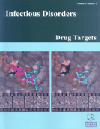- Home
- A-Z Publications
- Infectious Disorders - Drug Targets (Formerly Current Drug Targets - Infectious Disorders)
- Previous Issues
- Volume 8, Issue 4, 2008
Infectious Disorders - Drug Targets (Formerly Current Drug Targets - Infectious Disorders) - Volume 8, Issue 4, 2008
Volume 8, Issue 4, 2008
-
-
Editorial [Hot Topic: New Strategies and Tools to Identify Drug Targets on Infectious Disorders(Guest Editor: Jose A. Garcia-Sanz)]
More LessIn spite the great advances on biomedical sciences, and in particular on the analysis of the immune response regarding cells, mechanisms, signaling pathways and genes involved, together with a plethora of genetically modified animal models, infectious diseases still keep increasing in the world population, both on terms of morbidity and mortality. Naive CD4+ T lymphocytes, upon encountering antigen, differentiate to Read More
-
-
-
Th17 and Treg Cells, Two New Lymphocyte Subpopulations with a Key Role in the Immune Response Against Infection
More LessAuthors: Rolando Vernal and Jose A. Garcia-SanzIn addition to the T helper 1 (Th1) and Th2 lymphocyte subsets, two new subpopulations Th17 and regulatory T (Treg) cells have recently been described. Th17 cells, which produce high levels of interleukin (IL)-17, are dependent on the transcription factor orphan nuclear receptor RORC2/RORγt and have been implicated in exacerbating the immune response to infections. Conversely, Treg cells, either thymus-deriv Read More
-
-
-
Toll Like Receptor - Potential Drug Targets in Infectious Disease
More LessAuthors: Francois Erard and Bernhard RyffelToll like receptors (TLR) play a critical role in the recognition and response of pathogens by the innate immune system. Pathogen engagement of the TLR-MyD88 pathway favours the development of a protective Th1-biased T cell response. Interruption of TLR recognition or signalling has profound effects on innate immunity. Agonists or antagonists of specific TLRs modulate the host response to microbial infections and ha Read More
-
-
-
Transient Responses Via Regulation of mRNA Stability as an Immunological Strategy for Countering Infectious Diseases
More LessPosttranscriptional regulation of gene expression plays a pivotal role as a fast control system for T-cells and Bcells operating in the defense reactions against rapidly growing infectious agents. The framework of this machinery involves cis-acting elements in the mRNAs of relevant cytokines and trans-acting factors interacting with these elements. The cis- and trans-acting factors enforce rapid mRNA decay with oth Read More
-
-
-
Differential Splicing, Disease and Drug Targets
More LessAuthors: O. Villate, A. Rastrojo, R. Lopez-Diez, F. Hernandez-Torres and B. AguadoGenome complexity and diversity can be due to Alternative Splicing (AS), a process by which one gene can generate multiple mRNA isoforms and then several proteins. This is part of a normal process of variation on an individual, and when it is disrupted or modified, may trigger disease. To date, there are many pathologies described due to the effects of altered splicing isoforms, and effort is focused on the description of ne Read More
-
-
-
Translation Controlled mRNAs: New Drug Targets in Infectious Diseases?
More LessAuthors: Eva Diaz-Guerra, Rolando Vernal, Walter Cantero, Ernst W. Mullner and Jose A. Garcia- SanzRecent data from a series of laboratories has pinpointed the relevant role of translation control on the regulation of gene expression. In particular, an analysis of T cell activation has led to demonstrate that during this physiological transition about 20% of the regulated mRNAs are controlled at the translation level. Furthermore, modulating the host mRNA translation is one of the mechanisms used by infectious agents to achieve Read More
-
-
-
RNA Interference-Based Therapeutics: New Strategies to Fight Infectious Disease
More LessAuthors: M. Lopez-Fraga, N. Wright and A. JimenezFor many years, there has been an ongoing search for new compounds that can selectively alter gene expression as a new way to treat human disease by addressing targets that are otherwise “undruggable” with traditional pharmaceutical approaches involving small molecules or proteins. RNA interference (RNAi) strategies have raised a lot of attention and several compounds are currently being tested in clinical trials. Viru Read More
-
Volumes & issues
-
Volume 25 (2025)
-
Volume 24 (2024)
-
Volume 23 (2023)
-
Volume 22 (2022)
-
Volume 21 (2021)
-
Volume 20 (2020)
-
Volume 19 (2019)
-
Volume 18 (2018)
-
Volume 17 (2017)
-
Volume 16 (2016)
-
Volume 15 (2015)
-
Volume 14 (2014)
-
Volume 13 (2013)
-
Volume 12 (2012)
-
Volume 11 (2011)
-
Volume 10 (2010)
-
Volume 9 (2009)
-
Volume 8 (2008)
-
Volume 7 (2007)
-
Volume 6 (2006)
Most Read This Month
Article
content/journals/iddt
Journal
10
5
false
en


